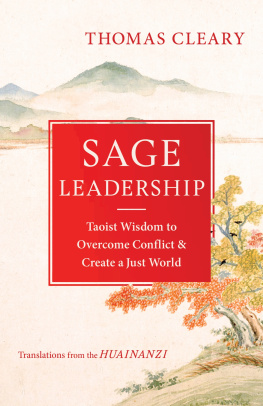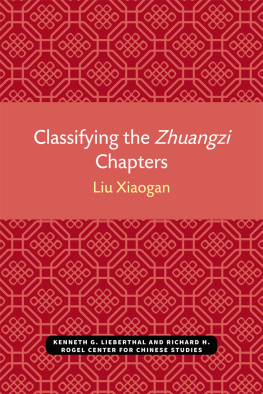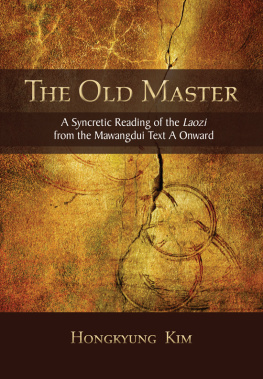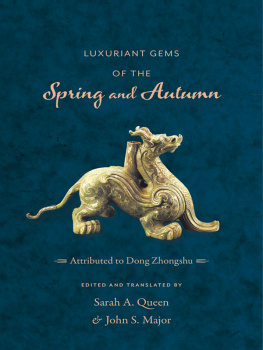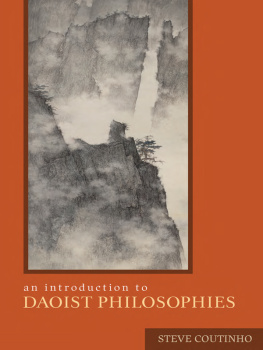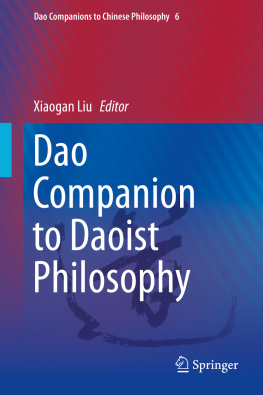THE ESSENTIAL HUAINANZI
TRANSLATIONS FROM THE ASIAN CLASSICS
T RANSLATIONS FROM THE ASIAN CLASSICS
Editorial Board
Wm. Theodore de Bary, Chair
Paul Anderer
Donald Keene
George A. Saliba
Wei Shang
Haruo Shirane
Burton Watson
THE ESSENTIAL
Huainanzi
Liu An, King of Huainan
TRANSLATED, EDITED, AND SELECTED BY
John S. Major Sarah A. Queen Andrew Seth Meyer Harold D. Roth
COLUMBIA UNIVERSITY PRESS NEW YORK


COLUMBIA UNIVERSITY PRESS
Publishers Since 1893
New York Chichester, West Sussex
cup.columbia.edu
Copyright 2012 Columbia University Press
All rights reserved
E-ISBN 978-0-231-50145-3
Library of Congress Cataloging-in-Publication Data
Huainan zi. English. Selections.
The essential Huainanzi / Liu An, King of Huainan ; translated, edited, and selected by John S. Major... [et al.].
p. cm. (Translations from the Asian classics)
Includes bibliographical references (p. ) and index.
ISBN 978-0-231-15980-7 (cloth : alk. paper)
ISBN 978-0-231-15981-4 (pbk. : alk. paper)
ISBN 978-0-231-50145-3 (e-book)
I. Liu, An, 179122 B.C. II. Major, John S. III. Title.
BL1900.H824E5 2012
320.01dc23
2011033920
A Columbia University Press E-book.
CUP would be pleased to hear about your reading experience with this e-book at .
CONTENTS
ca. 35002000 B.C.E.: Era of legendary sage-rulers
Appearance of advanced Neolithic jade-working cultures in several parts of China; complex chieftainships develop into protostates. The supposed era of the Divine Farmer, the Yellow Emperor, and other mythical sage-rulers and culture heroes.
ca. 19501550 B.C.E.: Xia dynasty
Dynasty supposedly founded by the flood-tamer Yu the Great. Beginning of the Bronze Age, beginning of hereditary monarchy. Last ruler is Tyrant Jie.
ca. 15501046 B.C.E.: Shang dynasty
Founded by Tang the Victorious. High Bronze Age culture: elaborate tombs and worship of royal ancestors, divination by means of oracle bones, earliest Chinese writing. Last ruler is Tyrant Djou.
1046771 B.C.E.: Western Zhou dynasty
Founded by Kings Wen and Wu, consolidated by the Duke of Zhou. China is divided into numerous states ruled by aristocrats owing ritual and military support to the Zhou kings.
722481 B.C.E.: Spring and Autumn period
Named for a chronicle kept by the dukes of Lu. Decline of Zhou royal power, emergence of large, powerful states and the ba hegemon system. Lifetime of Confucius (551479 B.C.E.).
481221 B.C.E.: Warring States period
Constant interstate warfare. Emergence of shi knights as a key social class. Numerous political thinkers debate ways to create an orderly, safe, and wellgoverned society.
221206 B.C.E.: Qin dynasty
Last Zhou king dies in 256 B.C.E. State of Qin begins campaign to conquer remaining warring states and consolidate their territory into a single empire. Campaign succeeds in 221; ruler takes the title First Emperor of Qin. Ambitious but overreaching centralization of power. First Emperor dies in 210; Qin state collapses in 206.
206 B.C.E.7 C.E.: Western (or Former) Han dynasty
206 B.C.E.: Liu Bang proclaims himself king of Han; takes title of emperor in 202. Liu Chang becomes first king of Huainan in 196.
195188 B.C.E.: Emperor Hui.
188180 B.C.E.: Interregnum of Empress Dowager L.
180157 B.C.E.: Emperor Wen. Liu Chang dies in 174; kingdom of Huainan temporarily abolished. Liu An becomes second king of Huainan in 164.
157141 B.C.E.: Emperor Jing. Kingdom of Huainan becomes a center of learning.
14187 B.C.E.: Emperor Wu. Huainanzi presented to emperor in 139 B.C.E. Liu An dies and kingdom of Huainan ends in 122 B.C.E.
THE ESSENTIAL HUAINANZI
The Huainanzi (The Master of Huainan) is a compendium of knowledge dating from early in Chinas Han dynasty (206 B.C.E.220 C.E.). It was compiled under the auspices of, and probably with the active participation of, Liu An (179?122 B.C.E.), the king of Huainan. Liu An was an influential member of the imperial family who ruled a sizable kingdom within the Han Empire. He also was known as an essayist, critic, poet, and patron of learning.
The Huainanzi was completed and presented to the imperial throne in 139 B.C.E. Its twenty-one chapters contain a comprehensive survey of contemporary knowledge, from self-cultivation techniques to the arts of rulership and from cosmology and geography to public speaking, military affairs, and the importance of education. The books final chapter summarizes the entire work and claims that it synthesizes the best features of all other schools of thought, thereby creating a compact yet comprehensive distillation of all knowledge necessary for ruling the empire. For readers today, it opens a fascinating window into the intellectual and political life of China in the second century B.C.E.
Historical Background
For much of the first millennium B.C.E., China was divided into a large number of states ruled by members of a hereditary aristocracy. Those rulers were nominally subject to the authority of the kings of the Zhou dynasty (1046256), but after the eighth century B.C.E. the power of the Zhou kings waned, and they had little control over state affairs. For a time, during the Spring and Autumn period (722481), the state rulers themselves tried to keep order, recognizing a succession of first-among-equals strongmen called ba (hegemons) who exercised authority on behalf of the Zhou kings. But that system eventually broke down, and during the Warring States period (481221), the states grew larger and more powerful but fewer in number as the larger states conquered and absorbed their smaller neighbors. Warfare and treachery were commonplace, and philosophers and political theorists had only moderate success devising systems of rulership that would restore order once again.
In the mid-third century B.C.E., just as the enfeebled Zhou dynasty was coming to an end, the king of the state of Qin embarked on a conscious program of conquest, intended to defeat the other states and bring all of China under his own dominion. Abolishing hereditary offices, the king instituted a merit-based bureaucracy in the state of Qin and mobilized the whole population for the twin purposes of agriculture and war. His campaign was successful, and the last of the Zhou-era states submitted to Qin in 221 B.C.E. Taking the newly coined title Qin Shihuangdi (First Emperor of Qin), he extended his strict laws and bureaucratic government throughout the country. He then embarked on an ambitiousand, as it proved to be, overly ambitiousprogram of public works: building roads, canals, a section of the Great Wall, and his own huge, magnificent tomb. When the First Emperor died in 210, the country erupted in rebellion and civil war, and the Qin dynasty collapsed. The causes of that collapse were complex, but the explanation widely accepted at the time emphasized the populaces resentment of the burden of taxes and labor service placed on them, as well as the regimes policy of inflicting severe punishments for even petty crimes.
The principle of a united China endured, however, after some initial backtracking. In 206 B.C.E., the rebel chieftain Liu Bang proclaimed himself king of Han, and four years later, having defeated the last of his rivals, he assumed the title of emperor. Having come to power, he had to decide what his new government would look like and to what extent it would reflect the centralizing tendencies of Qin. Initially the new emperor instituted a hybrid system, keeping most of western China under direct imperial control and dividing the lands in the rich eastern parts of the country into kingdoms, semiautonomous realms that were handed over to the emperors important allies and relatives. At the time, this would have been seen as a perfectly normal policy, sanctified by centuries of use. Soon, however, the Han dynasty found itself involved in a generations-long struggle to define the proper relationship between the imperial government and the neofeudal kingdoms. Rebellions and plots against the imperial throne by various regional kings were brutally suppressed in 196, 174, and 154 B.C.E. Some scholars suggest that at least some of these rebellions were provoked, and perhaps fabricated, by imperial authorities as a way of eliminating the regional kings and bringing their territory under imperial control.
Next page



